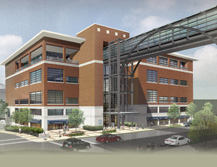Duquesne University Forbes Expansion Project
Multipurpose Recreational Facility
Forbes Avenue, Pittsburgh, PA
http://www.duq.edu/forbesproject
| Occupancy Type: | Mixed use (retail, athletic, classroom, etc.) | |
| Size: | 125,000 sq. ft. | |
| No. Stories: | 7 | |
| Project Team: | ||
| Owner: | Duquesne University | www.duq.edu/forbesproject |
| Architect: | DRS Architects, Inc. | www.drsarchitects.com |
| Structural: | Atlantic Engineering Services | www.aespj.com |
| Mechanical: | Dodson Engineering, Inc. | www.dodsonengineering.com |
| Electrical: | Hornfeck Electrical | www.hornfeck.com |
| Construction: | Jendoco Construction Corporation | www.jendoco.com |
| Construction Start: | March 14, 2006 | |
| Completion Date: | January 2008 | |
| Construction Cost: | $24 Million | |
| Delivery Method: | Design-Bid-Build |
| Special Conditions: | The facility ties to a pedestrian bridge over Forbes Avenue (designed and constructed by others) |
Architecture:
|
The architectural layout of the Multipurpose Facility is typically rectangular. Each floor is primarily a rectangular grid system divided into publicly and privately functioning areas. The exterior of the building is clad in masonry units and glass panels. The predominant exterior feature branches out from the building in the form of a steel pedestrian bridge, connecting to an adjacent parking garage. The bridge itself provides a lively extension, sprawling over top of the Forbes Avenue landscape. |
| Arch. Rendering: | http://www.duq.edu/forbesproject/rendering.jpg |
| Code Information: | IBC 2003 and other associated International codes, NEC 2002, ADA Requirements |
| Zoning: | Pittsburgh Zoning Code, Section 905.03, EMI/Educational-Medical Institue |
Building Envelope/Roof: |
The building envelope system is a typical brick and glass curtain wall structure. The roof consists fo a fabric reinforced thermoplastic sheet, rigid insulation on metal decking |
| Structure: | The structural system of the Duquesne University Athletic Facility is designed to comfortably accommodate the buildings many functions. The entire framing system is designed using wide flange, composite steel sections. On the lower floors, a more dense column grid is used to support office, retail, and smaller athletic spaces. The upper stories are comprised of spacious gymnasiums and public gathering areas requiring an open plan. These levels contain framing that must span more than half the width of the structure. Lateral resistance is provided via concentrically braced frames located behind the exterior walls. The entire building is supported by auger cast piles and grade beams. |
| Electrical: | The electricity for the Duquesne University Athletic Facility is provided to a 2000 amp main switch board and later converted to 480/277V and 208/120V power. Emergency power is provided to the building by a 275KW diesel generator. Lighting fixtures differ throughout the building with recessed, indirect fixtures in the office and classroom areas and pendant mounted metal halide fixtures in the gymnasiums. |
| Mechanical: | Duquesne University's newest building will have it's mechanical system anchored by six air handling units ranging in size from 5,000-33,000 cfm. |
| Transportation: | There are two main elevator and stair well locations that service the entire building from the basement to the top floors. There is also an additional freight elevator present. Along with these "in building" transportation options, there is an entrance from the connection bridge, attached at the 5th floor to an adjacent parking deck. |
| Fire Protection: | The entire building is fully sprinkled. |
